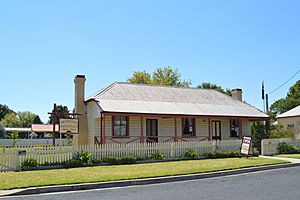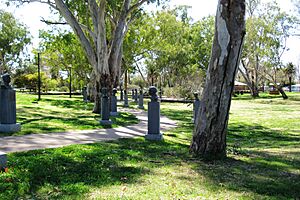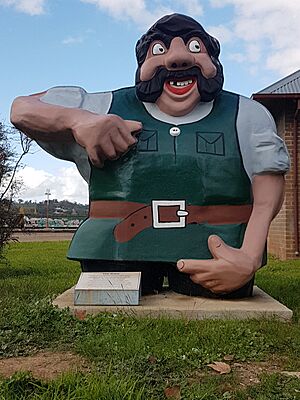Cootamundra facts for kids
Quick facts for kids CootamundraNew South Wales |
|||||||||
|---|---|---|---|---|---|---|---|---|---|

The CBC bank building and post office on Wallendoon St
|
|||||||||
| Established | 1861 | ||||||||
| Postcode(s) | 2590 | ||||||||
| Elevation | 318 m (1,043 ft) | ||||||||
| Location | |||||||||
| LGA(s) | Cootamundra-Gundagai Regional Council | ||||||||
| County | Harden | ||||||||
| State electorate(s) | Cootamundra | ||||||||
| Federal Division(s) | Riverina | ||||||||
|
|||||||||
Cootamundra, often called Coota, is a town in the South West Slopes area of New South Wales, Australia. It's part of the Riverina region and is managed by the Cootamundra-Gundagai Regional Council. In 2016, about 6,782 people lived there.
Cootamundra is famous as the birthplace of Sir Donald Bradman. He was an Australian cricketer, known as the greatest batsman of all time. The town is also known for the Cootamundra wattle flower. Each year, a big "Wattle Time" Festival celebrates when the wattle blooms. It includes an art show and other fun events.
Contents
History of Cootamundra
The first people to live in the Cootamundra area were the Wiradjuri tribe. The town's name likely comes from their word guudhamang, which means "turtle".
Cootamundra became a township on August 9, 1861. The first settlers bought land there in early 1862. Many people came to the area during the gold rush of the 1860s. After the gold ran out, Cootamundra became a peaceful farming community.
Important Dates in Cootamundra's History
- 1847 – The Cootamundra Run, a large stock farm, is the first European settlement.
- 1861 – The location for Cootamundra is officially announced.
- 1862 – Gold mining starts at the nearby Muttama Reef mine.
- 1864 – The first church (Anglican) and post office open.
- 1875 – The first school in the area opens.
- 1877 – Cootamundra gets its railway connection on November 1.
- 1884 – Cootamundra officially becomes a municipality (a town with its own local government).
- 1908 – Donald Bradman is born in Cootamundra.
- 1911 to 1968 – The Cootamundra Domestic Training Home for Aboriginal Girls operated. This institution housed Aboriginal girls who were forcibly taken from their families.
- 1942 – On December 3, the warship HMAS Cootamundra is launched. It was named after the town.
- 1952 – The town's name officially changes from Cootamundry to Cootamundra.
- 1986 – Australian singer John R Williamson releases his song 'Cootamundra Wattle'.
- 2000 – The first yearly beach volleyball competition begins. Sand is brought into the main street for "Coota Beach."
Things to See and Do
Cootamundra is in the South West Slopes and Riverina regions of New South Wales. It's part of the Cootamundra-Gundagai Regional Council.
The town is well-known as the birthplace of the famous cricketer Sir Donald Bradman. Even though he didn't live there for long, the town celebrates this link. You can visit the Sir Donald Bradman Birthplace Museum. It's the home where "The Don" was born and has cricket items and history.
The Coota Ex-Services Club is a place where you can eat and relax.
Cricket Captains' Walk
In 1998, statues of 14 Australian Test cricket team captains were put in Jubilee Park. These were made by sculptor Carl Valerius.
Later, in 2008, 30 more statues were added along a path. This made a full set of Australian Test cricket captains. Three more were added in 2020. The path is about 250 meters long and is easy for families, joggers, and wheelchairs.
A life-sized bronze statue of Bradman playing cricket is also nearby. Jubilee Park also has a barbecue area and a playground.
The Giant
"The Giant" is a large statue in Cootamundra. It used to be on top of a department store in 1975. Over the years, the building changed hands many times.
In 1985, a local couple, Allan and Phuong Jenkins, bought the statue. Allan even took "The Giant" with him on a marathon run around Australia! In 2014, they gave the statue to the Cootamundra Heritage Centre.
Local artists Jim and Robert Newman restored the statue in 2015. Today, "The Giant" stands next to the Heritage Centre on Hovell Street. It is considered one of Australia's many Big Things.
Population Information
The 2016 Australian census showed that 6,782 people lived in Cootamundra.
- About 5.6% of the people were Aboriginal and Torres Strait Islander.
- Most people (85.6%) were born in Australia. The next largest group (2.1%) was born in England.
- Most people (91.6%) spoke only English at home.
- For religion, the most common answers were Catholic (30.8%), Anglican (28.4%), and No Religion (16.4%).
| Historical population | ||
|---|---|---|
| Year | Pop. | ±% |
| 1921 | 1,748 | — |
| 1933 | 4,683 | +167.9% |
| 1947 | 5,259 | +12.3% |
| 1954 | 5,760 | +9.5% |
| 1961 | 5,939 | +3.1% |
| 1966 | 6,219 | +4.7% |
| 1971 | 6,530 | +5.0% |
| 1976 | 6,384 | −2.2% |
| 1981 | 6,540 | +2.4% |
| 1986 | 6,314 | −3.5% |
| 1991 | 6,386 | +1.1% |
| 1996 | 5,879 | −7.9% |
| 2001 | 5,486 | −6.7% |
| 2006 | 5,566 | +1.5% |
| 2011 | 5,579 | +0.2% |
| 2016 | 5,669 | +1.6% |
| 2021 | 5,732 | +1.1% |
| Source: Australian Bureau of Statistics data. | ||
Getting Around Cootamundra
The Cootamundra railway station is on the Main Southern railway line. Passengers can catch NSW TrainLink XPT trains to Sydney and Melbourne. There are also Xplorer trains to Griffith twice a week. Freight trains also pass through the town.
| Preceding station | Following station | |||
|---|---|---|---|---|
| Junee
toward Griffith or Melbourne
|
NSW TrainLink Southern Line
Griffith Xplorer
Melbourne XPT |
Harden
toward Sydney
|
||
TrainLink Coaches
Cootamundra is a hub for bus services run by Transport for NSW. These buses connect to other regional towns. Their times are set to meet certain train arrivals. You need to book seats ahead of time.
| Destination/s | Other stops | Service # | Frequency | Return # | Frequency | Notes |
|---|---|---|---|---|---|---|
| Condobolin | see timetable | 717 | Daily | 718 | Daily | |
| Tumbarumba | see timetable | 723 | Tue/Thu/Sun | 724 | Tue/Thu/Sun | |
| Griffith, Hay, Mildura | see timetable | 725 | Daily | 726 | Daily | ~20 min. refreshment stop at Hay |
| Yass Junction, Canberra, Queanbeyan | see timetable | 782 | Daily | 781 | Daily | ~15 min. stop at Yass Junction. Wheelchair access |
| Parkes, Dubbo | see timetable | 791 | Mon/Wed/Sat | 792 | Sun/Tue/Thu | Wheelchair access |
| Orange, Bathurst | see timetable | 793 | Tue/Thu/Fri/Sun | 794 | Mon/Wed/Fri/Sat | |
| Major stop on route: Wagga Wagga–Cootamundra–Canberra–Queanbeyan | see timetable | 704 | Tue/Thu/Sat (morning) | 703 | Tue/Thu/Sat (evening) | currently (2019) a trial service, trial timetable, Wheelchair access |
Airport
Cootamundra Airport is one of the oldest country airports in Australia that has been open continuously. From 1991 to 2002, a local airline called Country Connection Airlines offered flights from Cootamundra to Sydney and other regional places.
Sports in Cootamundra
Cootamundra has a strong history in sports. It's most famous for being the home of Sir Donald Bradman, the greatest test cricketer ever.
Today, the most popular sport in Cootamundra is rugby league. The local team is called the Cootamundra Bulldogs. They play in the George Tooke Shield competition. The club has produced famous players like Les Boyd, Eric Weissel, and Paul Field. The Bulldogs' home ground is named after Les Boyd.
Cootamundra also has an Australian rules football team, known as the Blues. They play in the AFL Canberra league. There's also a rugby union team, the Cootamundra Tri-Colours. The town also has a strong local cricket competition.
Famous People from Cootamundra
- Paul Beath (born 1968) – played for the Canberra Raiders and Manly Sea Eagles in the NRL.
- Les Boyd (born 1956) – grew up playing for the Cootamundra Bulldogs. He became a professional Rugby League player for Australia and NSW.
- Sir Donald Bradman AC (1908–2001) – Australian international cricketer, born in Cootamundra.
- Bob Holder – a rodeo champion known as the 'world's oldest cowboy.'
- Philip Lowe (born 1961) – former Governor of the Reserve Bank of Australia. He moved to Cootamundra when he was five.
- Isaac Smith (born 1988) – an AFL footballer.
- Eric Weissel (1903–1972) – a professional Rugby League player.
Climate
Cootamundra has hot, dry summers with thunderstorms. Winters are cool and cloudy with many rainy days. Sometimes, snow can fall in winter, like in August 2019. The town has a humid subtropical climate (Cfa).
| Climate data for Cootamundra Airport (1995–2022); 335 m AMSL; 34.63° S, 148.04° E | |||||||||||||
|---|---|---|---|---|---|---|---|---|---|---|---|---|---|
| Month | Jan | Feb | Mar | Apr | May | Jun | Jul | Aug | Sep | Oct | Nov | Dec | Year |
| Record high °C (°F) | 45.0 (113.0) |
43.0 (109.4) |
39.7 (103.5) |
33.5 (92.3) |
27.0 (80.6) |
22.0 (71.6) |
20.5 (68.9) |
24.8 (76.6) |
30.2 (86.4) |
34.9 (94.8) |
41.0 (105.8) |
42.2 (108.0) |
45.0 (113.0) |
| Mean daily maximum °C (°F) | 32.1 (89.8) |
30.4 (86.7) |
27.2 (81.0) |
22.7 (72.9) |
17.5 (63.5) |
13.9 (57.0) |
13.0 (55.4) |
14.6 (58.3) |
18.3 (64.9) |
22.4 (72.3) |
26.1 (79.0) |
29.3 (84.7) |
22.3 (72.1) |
| Mean daily minimum °C (°F) | 16.1 (61.0) |
15.5 (59.9) |
12.4 (54.3) |
7.5 (45.5) |
3.5 (38.3) |
2.2 (36.0) |
1.2 (34.2) |
1.5 (34.7) |
3.5 (38.3) |
6.3 (43.3) |
10.4 (50.7) |
13.0 (55.4) |
7.8 (46.0) |
| Record low °C (°F) | 2.0 (35.6) |
2.9 (37.2) |
0.9 (33.6) |
−4.0 (24.8) |
−6.5 (20.3) |
−7.3 (18.9) |
−7.8 (18.0) |
−7.0 (19.4) |
−6.0 (21.2) |
−3.5 (25.7) |
−1.4 (29.5) |
2.1 (35.8) |
−7.8 (18.0) |
| Average precipitation mm (inches) | 49.3 (1.94) |
52.3 (2.06) |
53.9 (2.12) |
35.3 (1.39) |
38.0 (1.50) |
60.7 (2.39) |
58.5 (2.30) |
58.4 (2.30) |
52.9 (2.08) |
48.6 (1.91) |
64.6 (2.54) |
52.7 (2.07) |
614.3 (24.19) |
| Average precipitation days (≥ 0.2 mm) | 6.8 | 5.4 | 6.5 | 5.1 | 7.6 | 10.8 | 12.9 | 11.8 | 9.0 | 8.5 | 8.4 | 6.7 | 99.5 |
| Average afternoon relative humidity (%) | 33 | 38 | 38 | 43 | 53 | 66 | 65 | 61 | 53 | 46 | 39 | 36 | 48 |
| Source: Bureau of Meteorology | |||||||||||||
Images for kids













